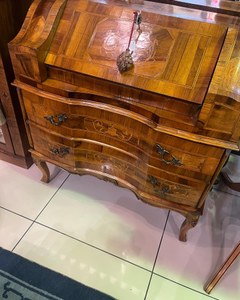The Holy Bible was always a family’s most treasured possession and in the early 17th Century, when bibles were printed, more families gained access to it. It was often the only book a family owned and the fly leaf and end pages were used to record important family information. Bible boxes were made to keep this treasure safe and were generally kept on a shelf in the living room. They were flat and just large enough to hold the family Bible. The head of the house would take it out on Sundays to read passages to the family gathering. Due to its design, a flat surface and convenient height, the owner would also use this box to write correspondence while standing.
During the 17th Century the Bible box was placed on a stand so that it could more easily be moved around. The frame made it low enough for the owner to sit down whilst using it as a writing surface. Over time the frame evolved with the addition of a top fitted to the desk with a slanting lid to make writing easier, as well as additional places where writing materials could be kept. By the late 17th Century the Bible box and bureau were separated.
The very first bureau writing desk was used during the reign of William and Mary of Orange. Their influence together with that of Queen Anne added much beauty to the writing desk and drawers were added to keep valuables in it. During the 18th Century the writing desk, as we know it today, was born. These desks were made with a flat table top covered in leather with drawers either at the bottom as legs, or on top. These desks were highly finished and often decorated with marquetry as it was placed in the middle of the room.
At Ghorbany Benmore we have an elegant Italian Louis XV style walnut & rosewood inlaid bureau.



